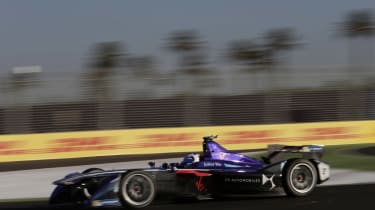Formula E's Sam Bird on electric racing, F1, and the future
We speak to Formula E's top Brit. What is racing in the electric single-seater series actually like?
We speak to Sam Bird just a couple of days after the Rolex 24 Hours of Daytona - and a heartbraking finish. Leading the GTD class in his Ferrari 488 GTB, the car expired towards the end of the 22nd hour.
Bird is pragmatic. He's buoyed by the team's pace - he'd pulled 13 seconds on the car behind - and enjoyed the experience racing with Scuderia Corsa. He doesn't say it, but this is definitely one of those, "but that's motorsport" situations.
We're at Virgin HQ in London to talk Formula E. Bird, driving for the DS Virgin Racing squad, has been a constant front-runner in the series, finishing in fourth place in the 2015-16 season (Formula E runs an October to July calendar) and taking three wins across the two-and-a-bit seasons so far.
You can read about evo's take on Formula E vs Formula 1 in issue 233, on sale now
Daytona seems like a completely different discipline from Formula E - do you approach Formula E in a different way, or is racing simply racing?
There are some similar aspects to the mental approach - you get nerves and adrenaline before the start of both races, there’s anticipation, there are my ideas of what I want to be able to achieve, there’s adrenaline because of that, and that’s the same in all walks of motorsport.
However the processes of driving and the skill sets required are slightly… well, very different. In Formula E I’m focused on conserving energy while going as quickly as possible, and in World Endurance I’m thinking about bringing the car home safely while still pushing as hard as possible, trying to beat different manufacturers like Ford and Aston Martin and Porsche.
In Formula E I’m trying to beat Seb Buemi in the Renault, and in a very different way - I’ve got to lift-coast, I’ve got to use regeneration of the battery. You race on street circuits - we don’t race on any street circuits in the WEC, so, you know, it’s a completely different discipline.
Is it more enjoyable driving flat out, as you might in the Ferrari rather than in Formula E?
No, I really enjoy both disciplines equally, and both have their unique challenges. When it’s 3 o’clock in the morning at Le Mans and you’re absolutely knackered, physically and mentally exhausted, your neck’s hurting, your arms are aching, your left leg’s tired from braking so much, the screen is completely murky with other cars’ oil and maybe there’s a bit of drizzle in the air... that’s tough!
But then so is having to manage energy so critically, while looking after the battery temperatures, looking after your state of charge, while you’ve got a couple of guys breathing down your neck on a street circuit. Make a mistake by two inches and you’re in the wall. Both are extremely difficult championships and I enjoy the challenges of both.
What is the core appeal to you of Formula E?
It’s the ability to go quickly while using as little energy as possible. The guy that can go the quickest, and use less energy than the others, is doing the best job in Formula E.
And do you enjoy the racing?
Yeah - you look at the racing that we’ve had, if you look at Buenos Aires last year, I have people coming up to me saying that was one of the most exciting races in Formula E so far. You had people fighting all the way down the field, there’s overtaking all the way down, normally every lap or every other lap there’s some kind of overtaking manoeuvre happening, or at least it’s extremely close - which you can’t realistically say in most other walks of motorsport.
There's also the glitz and glam of a street circuit, but we’ve still got overtaking which is quite nice.
Recently you commented on Twitter about the Berlin race moving back to Tempelhof. There’s been some resistance to some of the street circuits - from the green party in Berlin, and local residents in Battersea put the stop to the London race. What’s your view on the resistance to the street circuits?
I think they’re two extreme cases really - the Berlin one is very different to the London race. London was… how can I put it nicely… probably three old people in a flat that didn’t like the fact we used the park, and that was it. Because of their continuing uproar about it we had to move, which was a shame for the 80,000 people that came and enjoyed watching Formula E. We brought business to the local community, we showed off new and exciting innovative technology to London, and I believe we’ll be coming back to London very soon.
I don't know much about the Berlin situation, but it’s a shame. Again, the race was popular last year. We’re still going back to Berlin though - these things happen, and the good thing about Formula E is that we can be flexible, and restructure a race circuit in another area. You can’t move Silverstone and put it somewhere else!






